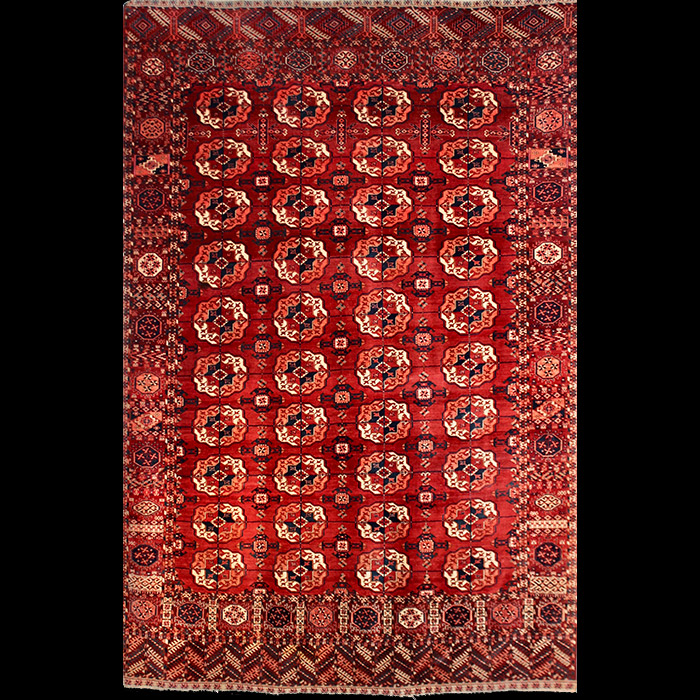Clay Stewart Collection of Türkmen Textiles
4. Türkmen Ahal Teke Main Rug
Ca. 1880. Size: 7 ft. x 10 ft.
Ca. 1880. Size: 7 ft. x 10 ft.

143 asymmetrical kpsi, pulled open to the right, with a width/height ratio of 1:1.2. Weft mostly invisible from the back. Two un-dyed single wool weft shoots in weft (Merv Teke feature, Moshkova). These asy/r Persian knots are symmetrical from the back (Akhal Teke feature, Moshkova), even warps are also a Turkic weaving configuration, even with the asymmetrical knots pulled open to the right. A relationship exists between horizontal knot nodes (from the back) and the size or height of the proportionately tall full go:ls, being an indication of extra age. Pile is cut medium high. Wool is lustrous and glossy with some light abrash. Very supple handle. Straight combed ivory wool warps, each made by twisting two strings into an s-ply. Possibly missing flat woven eight inch aprons on top and bottom ends, otherwise excellent condition with one small stain.
Gush go:ls, (Teke Turkmen Main rug Major go:l) is the traditional emblem of the Teke Turkmen tribe displayed only on their Main rugs.
The Minor gul here is called Gurbaga (Turkmen word for “frog”). This minor gul resembles a Greek cruciform in appearance with a star cross overlay. Gul means flower in Farsi and slave in Turkmen. A major gush go:l is an octagon (reference to the octagonal representation of a Pa-kwa, the Taoist yen yang symbol as the great Chinese circle of life with eight facets (or trigrams) representing the four elemental forces of nature (earth, heaven, fire, water), plus the next four (wind, thunder, lake, mountain) , and combining the eight elemental forces of nature and with the final two forces (being light and dark or yen and yang, male female, sun moon) complete an ancient Chinese Great Circle of Life. Another interpretation is perhaps more interesting i.e., three archetypal acorn shoots (birds) in each quadrant of the octagonal roundel motif. The word go:l in Turkmen means “lake” referencing irrigation or agriculture. Sometimes called the “bird” go:l or gush go:l referring to the symbols resembling “acorns” as birds also, both then becoming a double entendre symbol. In the field are four columns of ten major gush go:ls each and three columns of eight gurbaga minor guls each.
Top row only shows three full chemche guls and two half guls from each side protruding inwards, a variant of the gurbaga minor gul, each with white ram’s horns (gochanak motif) each on the four ends of their four stems. And in addition on the eighth row only, the gurbaga guls have a white gochanak motif. All the Main go:ls are all cross linked in their center vertically and horizontally on both axis by a thin dark blue line (blue is the color reserved for Satan) creating a grid like effect (common on the larger Take Turkmen Main rugs). Half gurbaga minor guls protrude into the field on both sides around its whole perimeter. The main border shows repeated amuletic symbols portraying the sun on its yearly journey around the tribe. Repeated variations of the Shelpe Gocha octagonal motif (lit. Jewelry pendant) and alternating compartments increasing the power of the amuletic designs inside. Flanking both sides are guard borders displaying repeated and reciprocating gochanak designs. The major border is proportionately smaller rather than larger (Moshkova). These larger Turkmen rugs are repositories of the tribe’s heraldic traditional emblems unique to that tribe and identifying them to all others.
Celebratory family meeting rugs reserved for formal occasions, visitors of rank, etc. reflecting the status, wealth and tribe of the owner, usually a chief.
Akhal Oasis, Goek Tepe, site of ancient fortress where the Akhal Teke camped in the second half of the 19th century, forty miles west of Ashkabad in Turkmenia. Home to the Akhal (white beard) Teke Turkmen nomads.
Visit Glossary page for any further definitions not highighted in red in a pop-up window.